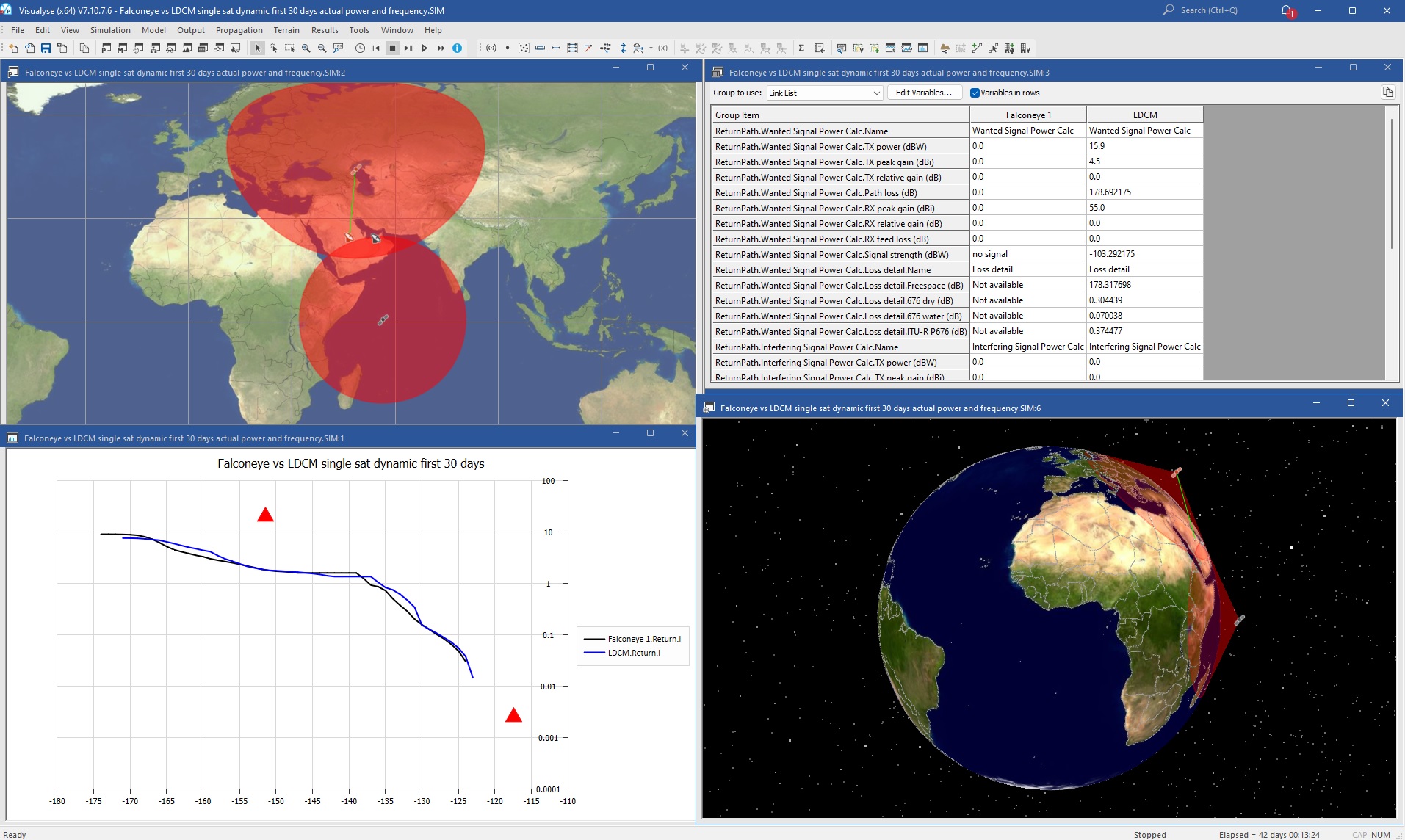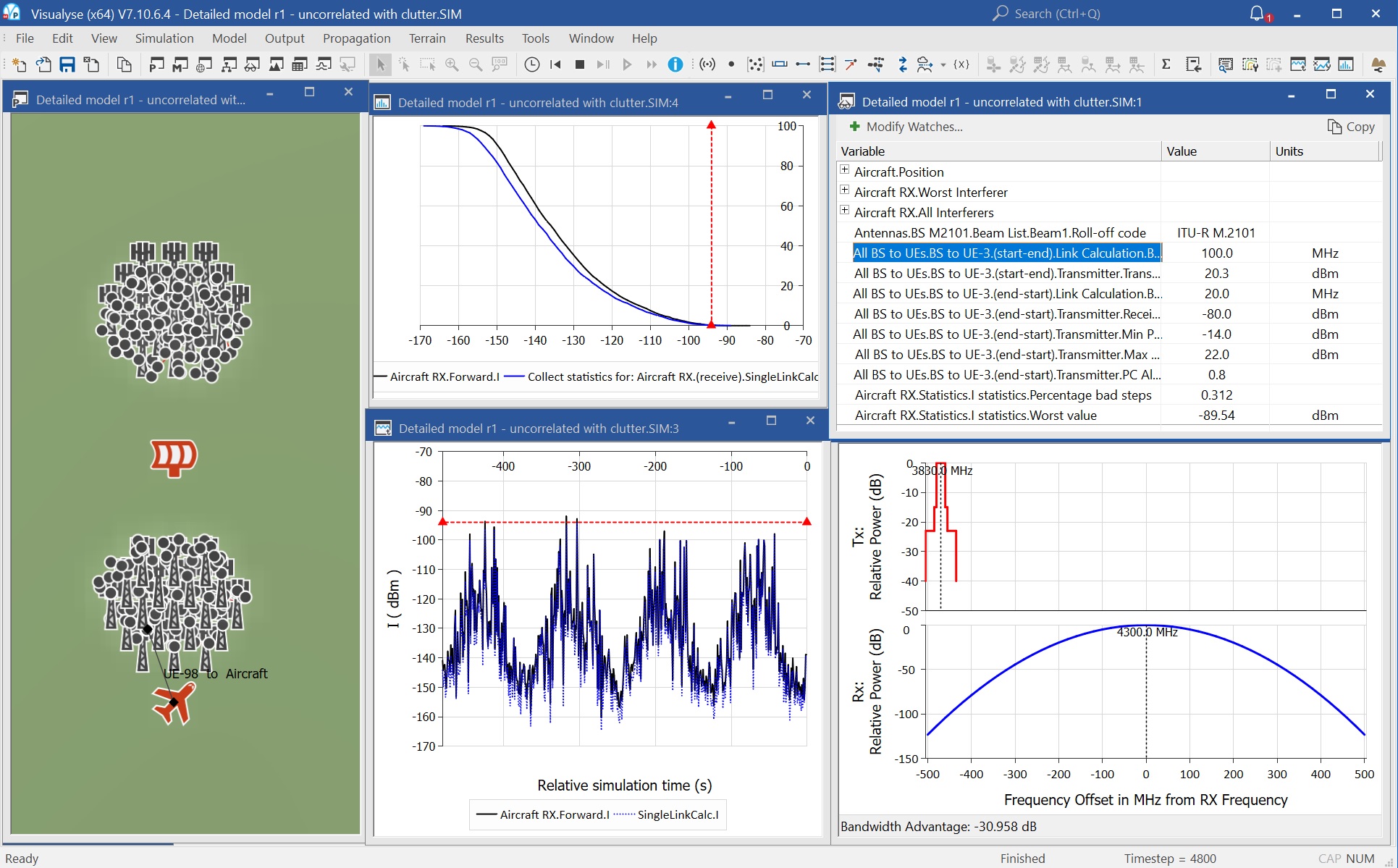Introduction
Transfinite Systems markets specialist software products for radio interference analyses and also offers a world-class consultancy service. Our consultants have considerable experience in developing software simulations applied to complex coexistence studies and practical frequency coordination work.
This page gives an overview of our capabilities and the consultancy work that we do for clients across the world.
What we do
We engage with a wide range of radio spectrum engineering tasks. From developing software simulations that contribute to sharing and compatibility studies under consideration within the International Telecommunication Union (ITU), to supporting license applications where the applicant is required to provide a technical analysis by the spectrum regulator.
We support our clients at regulatory meetings, presenting papers and arguments backed up by our technical analyses. We are collaborative and can do this as part of a larger team or delegation when required.
The investigations that we undertake via our software often require writing up. We are experienced authors of engineering reports and papers including inputs to ITU Working Parties and other international fora. Whether it’s a substantial and detailed study report or a short discussion paper, our consultants will deliver a high standard of technical writing.
Our consultancy service is not limited to any particular sector or technology within radiocommunications. We work on studies that involve satellite, terrestrial, maritime and aeronautical radio services, including emerging technologies. We have no bias and our industrial, legal, government and military clients extend across all radio services and applications.
The scope of our consultancy work encompasses:
-
Frequency coordination of satellite networks
Transfinite Systems has decades of experience supporting our clients through the frequency coordination process including detailed engineering analyses via software simulation and negotiations with third parties
-
Satellite and terrestrial systems
We engage with spectrum engineering problems involving both satellite and terrestrial networks and have as much expertise in simulating fixed and mobile terrestrial deployments, for example, as we have with modelling satellites
-
Emerging technologies
Our consultants support efforts to secure spectrum access for new and emerging technologies via detailed interference studies, advocacy and representation
-
Spectrum sharing and compatibility problems
We have contributed a great many studies of spectrum sharing and compatibility problems to ITU study groups and other fora on behalf of clients
-
Regulatory support
Working with spectrum regulators and industry clients, we can help develop regulatory arguments, technical procedures and documentation including client representation and support at international meetings of the ITU and other regulatory fora
-
License applications
Regulators sometimes require a detailed interference analysis and preparation of technical data as part of their license application process and we are able to support our clients with these tasks
-
Reports and papers
Our consultants are experienced authors of high-quality reports, papers and regulatory documentation including submissions to domestic regulatory bodies and international meetings
-
Training
Transfinite Systems offers training to clients across our range of software products and in the radio spectrum engineering principals that underpin and inform detailed modelling and analysis of the interference environment
Our software simulation work
Our consultants are expert users of Transfinite’s Visualyse range of software products and experienced at developing models of the radio interference environment. Depending on the task at hand, these models can be smaller scale, involving one victim receiver and one interferer, for example, or on a larger scale, involving models of aggregate interference sourced to thousands of transmitters.
The complexity of these models varies and we are familiar with simple, worst-case, analyses and more detailed statistical models. The level of complexity required depends on the interference problem or, sometimes, which stage we are at within a period of study. A worst-case analysis can be appropriate when we want to assess whether a risk of harmful interference actually exists, say, while a more complex study can deliver the statistics required to quantify and properly understand such risks. Whatever the complexity of the modelling, our aim is to provide technically robust evidence that is a serious contribution to regulatory discussions or that satisfies the requirements of coordination or licensing procedures. We can help our clients formulate arguments, proposals, coordination agreements or license applications, based on the results of our modelling work.
Our Visualyse software products are highly configurable and famous for their flexibility. They are used by our consultants, and by many other expert users across the world, to model and resolve a wide range of radio interference problems.
We stay abreast of developments and our software is often leading the way regarding implementation of internationally agreed modelling guidelines. Our consultants are routinely exposed to new problems and a feature of our consultancy is that we tackle these challenges head on, including development of our software if required.
We can build detailed models of terrestrial and satellite networks using inputs specified by clients or spectrum regulators. The output of a simulation could be an interference graph, say, giving the probabilities associated with excess interference or a contour capturing the geographical areas where an interferer’s location causes a victim receiver’s interference threshold to be exceeded.
Spectrum engineering problems and the associated software simulations can be complex but our consultants will always aim to deliver concise and easily understood results that add weight to our client’s position.
White Papers, Technical Notes and other papers published by Transfinite, covering a range of engineering and software modelling problems can be accessed via the Papers section of our website.
Examples include non-GSO satellite coordination at:
https://www.transfinite.com/Content/Non_GSO_Satellite_Coordination

Another example is 5G sharing with aeronautical radar altimeters at:
https://www.transfinite.com/Content/Modelling_Interference_from_5G_System_into_Radar_Altimeters

Our consultants
Transfinite’s lead consultants are Ian Flood, John Pahl and John Parker.
Ian Flood
Ian Flood is an experienced engineer specialising in spectrum sharing studies and interference management problems.
Since joining Transfinite in 2013, Ian has worked on studies involving Wi-Fi, fixed links, satellite services and mobile services. Specific problems include adjacent channel compatibility between mobile and fixed satellite services, interference from terrestrial mobile networks into mobile satellite user links and the development of a mathematical method for precise service apportionment in spectrum sharing and compatibility studies. His work involves representation at various international fora.
Ian is a Chartered Engineer and holds a PhD in graph-theoretic studies from Cardiff University. He is a member of the Institution of Engineering and Technology and the London Mathematical Society. He has written several peer reviewed journal papers and other articles on aspects of spectrum engineering.
John Pahl
John Pahl was a founding director of Transfinite Systems in 1994 and led on the development of our Visualyse Professional software.
Regulatory support, coordination studies, system design, radiowave propagation, spectrum efficiency and spectrum occupancy studies are all part of John’s consultancy work. He is experienced in modelling a wide range of satellite, terrestrial, maritime and aeronautical radio systems. Examples include a geographic sharing study between new mobile services and incumbent services and the development of an algorithm for coordination between non-geostationary and geostationary satellites. He delivers expert training across the Visualyse range of software products and on associated spectrum engineering topics.
He has specialised expertise on issues related to Equivalent Power Flux Density (EPFD) limits associated with Article 22 of the Radio Regulations and the algorithm in Recommendation ITU-R S.1503 to facilitate operation of non-geostationary systems while ensuring protection of geostationary networks. He is the chair of the Sub Working Group on revisions to Recommendation ITU-R S.1503 at ITU Working Party 4A and chaired the drafting group on EPFD studies at the World Radiocommunications Conference in 2023.
John has written papers on subjects related to spectrum issues which have been published in peer reviewed journals and given presentations at industry conferences. John holds a Master’s degree in mathematics from Cambridge University and is the author of the book "Interference Analysis: Modelling Radio Systems for Spectrum Management" published by Wiley.
John Parker
John Parker was a founding director of Transfinite Systems in 1994. He worked on the original specification and development of the Visualyse product range in the early 1990s and has continued to support the Visualyse user community.
As an experienced consultant, John’s work covers a wide range of spectrum engineering problems with focus on spectrum sharing studies and the promotion of more efficient use of spectrum through the improvement of numerical methods and simulation. Examples include a study of adjacent band interference from microwave fixed links into Earth Exploration Satellite Service receivers and analyses involving the development of receive contours for satellite earth stations in support of license applications. John has developed and delivered training courses for Transfinite and delivers expert training over the Visualyse software product range.
John has written peer reviewed journal papers on spectrum engineering topics. He holds a PhD in theoretical physics from the University of Manchester and an MBA with a specialisation in financial strategy.
Contact us
For further information about Transfinite’s consultancy service and software products please contact us at:
Transfinite Systems Ltd
Suite 24 (5th Floor)
AMP House
Dingwall Road
Croydon
Surrey
CR0 2LX
United Kingdom
Telephone: +44 (0)20 3904 3220
Fax: +44 (0)20 3904 3211
Web: https://www.transfinite.com
Email: info@transfinite.com
LinkedIn: https://www.linkedin.com/company/transfinite-systems-limited
